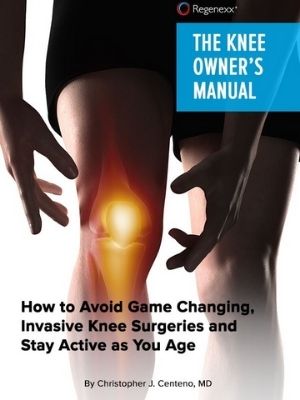Hamstring Pain Behind the Knee: How It Happens, Causes & Treatment Options
Get Help With Hamstring Pain Behind KneeExperiencing hamstring pain behind the knee can not only hinder your daily activities but also significantly impact your quality of life. This discomfort is often the result of a variety of factors, ranging from acute injury to chronic conditions. Understanding the underlying causes, symptoms, and potential treatment options is crucial for those seeking relief and a return to normalcy.
This comprehensive guide aims to shed light on the complexities of hamstring pain located behind the knee, offering insights into how it occurs, its common causes, and effective treatment methodologies designed to alleviate pain and restore functionality.
Hamstring Pain and Where It Hurts
The hamstring muscle is a group of three muscles located at the back of the thigh, functioning together to facilitate various movements of the hip and knee. These muscles are essential for many activities, including walking, running, and jumping. They enable the bending of the knee and the extension of the hip, movements that are fundamental to most lower-body activities.
The hamstrings consist of three main muscles:
- Semitendinosus: This muscle originates from the sit bones and inserts into the medial (inside) aspect of the tibia, just below the knee. It is involved in the following functions:
- knee flexion or bending the knee
- hip extension or moving the thigh backward
- internal rotation of the thigh.
- Semimembranosus: Like the semitendinosus muscle, the semimembranosus muscle also originates from the sit bones and inserts into the medial tibia. It performs similar functions: knee flexion, hip extension, and internal rotation of the thigh. Additionally, it helps stabilize the knee joint.
- Biceps femoris: This muscle has two parts: a long head and a short head. The long head originates from the sit bones, while the short head originates from the femur. Both heads are inserted into the head of the fibula, a small bone located on the lateral side of the tibia.
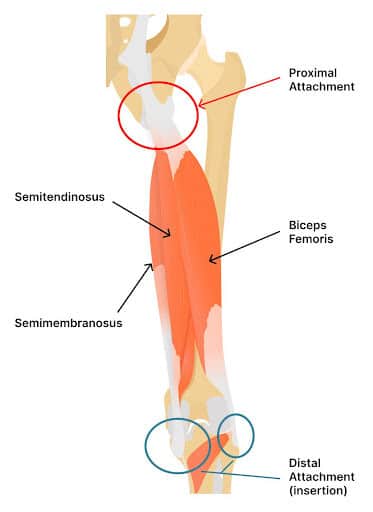
Hamstring pain is typically characterized by discomfort in the back of the thigh, ranging from mild soreness to intense, debilitating pain.
The possible locations of hamstring pain include:
- Proximal tendon attachment: This is where the hamstring tendons attach to the ischial tuberosity, colloquially known as the “sitz bones.” Patients often describe this as lower butt pain.
- Muscle belly: This is the thick, central part of the muscle. Pain here is often due to muscle strains or tears.
- Distal tendon attachment: These are the points where the hamstrings attach near the knee, on the back of the tibia and fibula. Patients often describe this as pain behind the knee.
Pain Manifestations and Their Causes
Hamstring pain located behind the knee primarily implicates the distal tendon attachments of the hamstring muscles. This specific region is where the tendons of the hamstring group attach to the bones of the lower leg: the tibia and the fibula. Both the semitendinosus and semimembranosus muscles attach to the inside aspect of the tibia, whereas the biceps femoris inserts into the fibula.
Pain behind the knee is a symptom that can arise from a variety of causes, including issues with the hamstring tendons but also extending beyond them. Other causes of posterior knee pain are discussed in detail below.
Associated and Accompanying Symptoms
When experiencing hamstring pain behind the knee, several associated and accompanying symptoms may be present. The most common include:
- Swelling and tenderness: Swelling and tenderness can occur due to inflammation. These symptoms are indicative of tissue damage, which could range from mild strains to complete tendon tears.
- Bruising: Bruising associated with hamstring pain behind the knee typically indicates underlying tissue damage, such as a strain or tear, where blood vessels have been impacted and blood leaks into the surrounding tissues. This visual manifestation of injury often accompanies more severe hamstring injuries.
- Weakness in the leg: There might be a noticeable weakness in the leg, especially when attempting to perform activities that involve the hamstring muscles, such as running, jumping, or even walking. This weakness can result from the pain itself or actual damage to the muscle fibers.
- Muscle stiffness: The knee and the surrounding area may feel stiff, particularly after periods of rest. This stiffness can limit the range of motion, making it difficult to fully bend or straighten the leg.
- Popping or snapping sensation: In cases of a severe tear, individuals might experience a popping or snapping sensation at the time of injury, consistent with tendon irritation/dysfunction.
- Difficulty sitting or walking: Activities that put strain on the hamstrings, like standing, walking, running, or bending the knee, can exacerbate the pain.
Other Possible Conditions Causing Pain Behind the Knee
Understanding the variety of conditions that can contribute to pain behind the knee is crucial for targeted diagnosis and effective treatment. While hamstring-related issues are common culprits, several other conditions can elicit similar discomfort. These are:
Baker’s Cyst (Popliteal Cyst)
This is a fluid-filled swelling behind the knee that can cause a bulge and a feeling of tightness. Pain can worsen when extending the knee or when active.
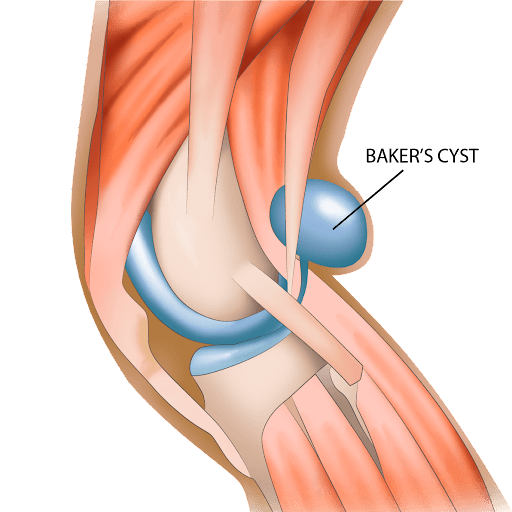
Pes Anserine Bursitis
The pes anserine bursa is a small, fluid-filled sac located on the inner side of the knee, just below the joint. It acts as a cushion to reduce friction where the tendons of three muscles – the sartorius, gracilis, and semitendinosus – attach to the medial side of the tibia (lower leg bone). The bursa can become inflamed causing pain, tenderness, and swelling just below the knee joint.
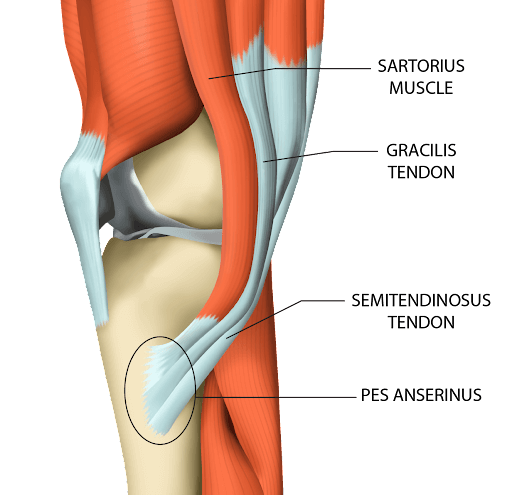
Meniscus Tears
The meniscus is a C-shaped piece of cartilage that acts as a cushion within the knee joint. It is sandwiched between the femur and tibia (shin bone). There are two menisci in each knee – one at the outer edge (lateral) and one at the inner edge (medial). If the tear occurs in the posterior (back) part of the meniscus, it can cause pain specifically in the back of the knee.
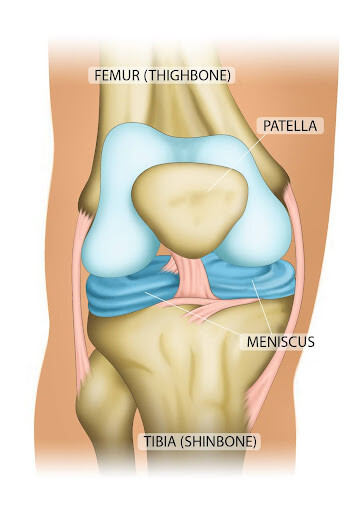
Osteoarthritis of The Knee
The knee joint is lined with cartilage to facilitate smooth, effortless movement of the joint. Osteoarthritis of the knee causes pain behind the knee, or posterior knee pain, primarily through the breakdown of cartilage, leading to joint space narrowing. This degradation increases stress on the joint, including its posterior aspect, resulting in pain.
Additionally, the formation of bone spurs can irritate tissues at the back of the knee, while inflammation within the joint can lead to fluid build-up, creating pressure and pain in the posterior knee area. These changes disrupt normal knee function, manifesting as stiffness, pain, and reduced mobility, including pain behind the knee.
Gastrocnemius Tendinopathy
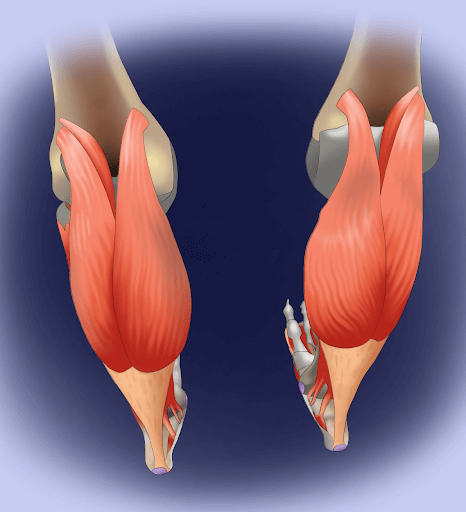
The gastrocnemius muscle is a superficial two-headed muscle that is in the back part of the lower leg. The medial head of the gastrocnemius originates from the medial condyle of the femur, whereas the lateral head originates from the lateral condyle. The heads come together and merge into the Achilles tendon at the heel. Its principal function is bending the knee and pointing the foot downward. It plays a key role in walking, running, and jumping.
Gastrocnemius tendinopathy occurs when there is irritation or damage to the tendon of the gastrocnemius muscle, leading to tenderness and pain behind the knee.
Deep Vein Thrombosis (DVT)
A deep vein thrombosis (DVT) is a blood clot that forms in a deep vein, typically in the legs. The clots can partially or completely block blood flow through the veins, leading to pain behind the knee, swelling, and tenderness.
Ligament Injury:
Ligaments are thick bands of fibrous connective tissue that connect bone to bone. They are found throughout the body, as they provide stability and limit movement of the joints. The knee has an extensive number of ligaments, which include the ACL, PCL, MCL, and LCL. Injury of the PCL can cause pain behind the knee along with swelling and tenderness.
Sciatica
Sciatic or low back injuries can cause hamstring pain behind the knee through a mechanism involving nerve compression and referred pain. The sciatic nerve, which is the largest nerve in the body, originates from nerve roots in the lower back and travels down through the buttocks and the back of the leg, down to the feet.
Nerve compression can occur as a result of disc bulges, disc herniation, and spinal stenosis, causing pain that radiates from the lower back through the buttocks and down the back of the leg.
Referred pain can also occur as a result of injuries to the low back. Injuries to the SI joint, lumbar ligaments, and facet joints can cause hamstring pain behind the knee.
Nerve Entrapment
Nerve entrapment causing hamstring pain behind the knee typically involves the sciatic nerve or one of its branches. When this nerve or any of its branches are compressed or trapped, it can lead to symptoms including pain, tingling, numbness, or weakness along its path, affecting areas like the back of the thigh and knee.
Immediate Treatment for Pain in the Back of the Knee
Immediate treatment for pain in the back of the knee focuses on alleviating pain, reducing inflammation, and preventing further injury. This area can be sensitive due to the large number of structures in the back of the knee, which include tendons, ligaments, and the popliteal bursa.
The cause of the pain can range from overuse injuries, ligament strains, and hamstring injuries, to more specific conditions like Baker’s cysts or nerve entrapment. Here is a step-by-step approach to treating knee pain quickly and effectively at home.
Rest
Rest plays a foundational role in the initial management of knee pain, serving as a crucial step in reducing further stress on the affected area. Following the principle of rest, it’s imperative to:
- Limit movement: Avoid activities that exacerbate the pain. This helps prevent further strain on the injured area.
Elevation
Elevation is an effective strategy to reduce swelling and promote the healing process. By raising the level of the affected leg above the heart, gravity aids in decreasing fluid accumulation in the knee area. This not only minimizes inflammation but also alleviates pain by reducing pressure on the knee structures. For effective elevation:
- Elevate the leg: Raise the leg higher than the heart level. Use pillows to prop up the leg when lying down. Elevation helps reduce swelling by improving venous return.
Compression
Compression is an essential component of treating knee pain, specifically designed to reduce swelling and provide support to the affected area. By applying consistent pressure around the knee, a compression bandage helps to limit the movement of fluids into the knee joint, thereby decreasing inflammation and stabilizing the knee for healing. Here’s how:
- Use a compression bandage: Gently wrap a compression bandage around the knee. This can help reduce swelling. Be careful not to wrap it too tightly as it can impede circulation.
Pain Relief
Safe anti-inflammatory medications include good quality fish oil and curcumin. Non-steroidal anti-inflammatory drugs (NSAIDs) are powerful anti-inflammatory medications that can reduce pain but have significant side effects and therefore should be avoided.
- Considerations for NSAID use: Although NSAIDs can be effective in reducing inflammation and pain, their use is not without risks. Significant side effects associated with long-term or excessive use of NSAIDs include gastrointestinal issues such as ulcers and bleeding, kidney damage, increased blood pressure, and an elevated risk of heart attack or stroke.
It’s crucial for patients to consult with their healthcare professionals before starting any NSAID regimen, particularly for individuals with pre-existing conditions or those taking other medications.
Common Treatments for Hamstring Pain
This is where an accurate diagnosis is critical. As discussed above, other medical conditions can cause pain behind the knee similar to that of distal hamstring tendon injuries. Treatment is dependent on the underlying injury.
Common treatments for pain behind the knee due to hamstring injuries include:
- Rest and activity modification: As noted above, an important first step in treating hamstring pain is to rest the knee by avoiding activities that worsen the pain.
- Compression and elevation: Compression can help reduce swelling and provide support to the injured area. Elevation of the leg above the heart can decrease swelling by improving venous return.
- Bracing and taping: Using a brace or tape can support the hamstring and reduce stress on the injured area.
- Physical therapy: Physical therapy is a cornerstone of hamstring rehabilitation. A physical therapist will develop a personalized program that includes stretching and strengthening exercises aimed at restoring the muscle’s strength and flexibility. Therapy may also include techniques such as massage, ultrasound, or electrical stimulation to promote tissue healing.
- Alternative treatments: Some patients may explore alternative treatments like acupuncture or chiropractic care, which can help manage pain and improve function.
- Regenerative treatment options: These options include prolotherapy, platelet-rich plasma (PRP), and bone marrow concentrate, which are discussed below.
- Surgery: Surgery for hamstring pain is generally reserved for severe cases, such as complete muscle tears or avulsions, where the tendon detaches from the bone. Surgery involves reattaching the torn muscle or tendon to the bone.
The Regenexx Regenerative Protocol for Painful Hamstring and Knee
At the Centeno-Schultz Clinic, securing an accurate diagnosis is crucial. Pain behind the knee can arise from several different clinical situations, each with different treatment options.
Hamstring injuries that have not responded to conservative care, rest, and physical therapy can be treated with PRP therapy. This therapy utilizes concentrated platelets from the patient’s own blood, which are then injected into the injured area to potentially accelerate the healing of injured tendons, ligaments, muscles, and joints.
How PRP Works
PRP injections are prepared by taking a sample of the patient’s blood and processing it in a centrifuge to concentrate the platelets. At the Centeno-Schultz Clinic, we have a state-of-the-art cell laboratory that can customize PRP concentration for each patient’s needs.
This concentrated platelet-rich plasma is then injected directly into the injured area under ultrasound guidance. The high concentration of growth factors in platelets is believed to stimulate the healing process. Notable growth factors include platelet-derived growth factor (PDGF), vascular endothelial growth factor (VEGF), and epidermal growth factor (EGF).
Efficacy in Hamstring Injuries
Research suggests that PRP can be particularly beneficial for treating hamstring injuries, which are common in sports that require sudden starts and stops or rapid changes in direction. These injuries can be debilitating and often recur, making effective treatment crucial for athletes.
Studies, including case series at collegiate levels, have demonstrated promising outcomes with PRP treatment, showing that it can reduce recovery time and help athletes return to sport more quickly than traditional treatments alone (1).
- Faster recovery: In cases of hamstring injuries, PRP has been shown to help accelerate the healing process. For example, one study noted a significant reduction in recovery time in athletes receiving PRP injections compared to those undergoing conventional rehabilitation alone.
- Reduced recurrence: PRP may also decrease the likelihood of injury recurrence. By promoting more complete healing of the hamstring tendons and muscles, PRP can potentially increase the overall resilience of the treated area.
- Return to play: Many athletes treated with PRP injections for hamstring injuries have successfully returned to their sports at the same or an even higher level of performance. This is particularly significant given the high demands of collegiate and professional sports.
Avoid Invasive Treatments with Centeno-Schultz
The hamstring is a group of three muscles located in the back of the thigh: semitendinosus, semimembranosus, and biceps femoris. Hamstring dysfunction and pain can occur at the proximal tendon attachment at the sitz bone, muscle belly, or distal tendon attachment where the hamstrings attach to the bones of the knee (tibia and fibula).
Hamstring pain behind the knee arises primarily due to issues at the distal tendon attachments. This pain can manifest as swelling, bruising, stiffness, and weakness in the leg, which can complicate everyday activities like walking, running, and jumping. Other symptoms may include a popping sensation, difficulty sitting or walking, and tenderness.
Various conditions can cause similar symptoms, including Baker’s cysts, meniscus tears, osteoarthritis, gastrocnemius tendinopathy, deep vein thrombosis (DVT), ligament injuries, and issues related to sciatica or nerve entrapment.
An accurate diagnosis is essential. At the Centeno-Schultz Clinic, board board-certified, fellowship-trained physicians will review each patient’s past and current medical history, medications, and surgeries along with a detailed physical examination and review of radiographic imaging to ensure that the correct diagnosis is made.
Regenerative treatment includes PRP, which can improve healing and avoid the toxicity and dependence on medications and the risks associated with surgery.
Download this guide on How To Avoid Knee Surgeries
Reference:
- Lee KY, Baker HP, Hanaoka CM, Tjong VK, Terry MA. Treatment of patellar and hamstring tendinopathy with platelet-rich plasma in varsity collegiate athletes: A case series. J Orthop. 2019 Oct 31;18:91-94. doi: 10.1016/j.jor.2019.10.007. PMID: 32189891; PMCID: PMC7068016.
